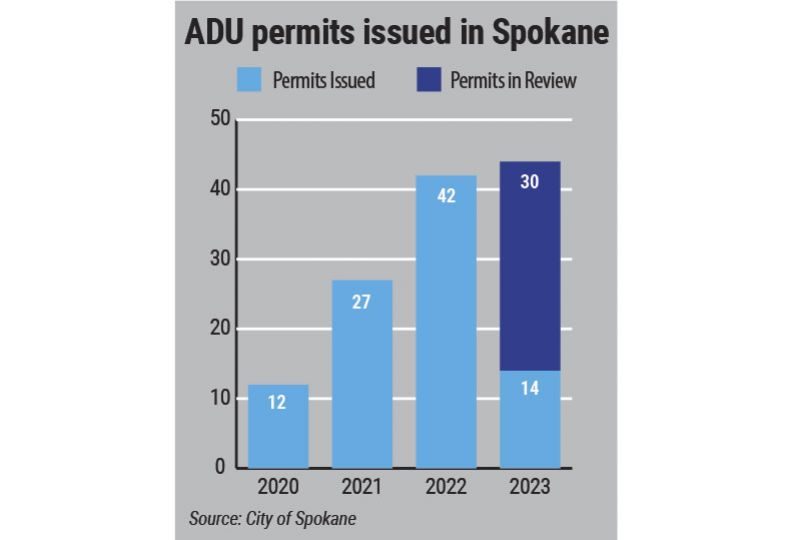
Home » Loosening of housing regulations leads to uptick in permitting
Loosening of housing regulations leads to uptick in permitting
Still, fewer than 50 units approved, in process so far in city this year

June 22, 2023
Last June, the fanfare announcing changes to building development standards was at an all-time high and touted by some as a much-needed step forward to help the city of Spokane’s housing crisis.
Nearly a year after the city loosened restrictions on the construction of accessory dwelling units in single-family homes, ADU applications permitted or under review are outpacing previous years’ applications, says Tami Palmquist, director of development services for the city of Spokane.
Still, the totals for accessory dwelling units alone aren’t high enough to make much of an impact on the housing stock, some city leaders caution.
Accessory dwellings are usually small self-contained residential units located on properties that have single-family homes or another type of residence.
Through the end of May, the city has issued 14 ADU permits, with 30 more under review.
For all of last year, the city issued 42 permits for accessory dwelling units—a 55.6% increase from permits issued in 2021. In 2020, there were 12 total ADU permits issued, says Palmquist.
Joel White, executive officer of Spokane Home Builders Association, says the code amendments last summer aren’t solving the housing crisis, but they are a necessary part of the solution.
Michael Cathcart, City Council member, concurs and says, “This alone is not making a substantial change yet in any sort of capacity or an increase in units.”
Accessory dwelling units are also known as in-law suites, granny flats, or carriage houses. They differ from accessory structures, which are buildings for storage, greenhouses, or garages.
An ADU typically has in-unit amenities such as a kitchen and space for living, sleeping, and eating. They can be located in a separate unit within an existing home, such as in attics or basements; or in home additions; or in detached structures on the same lot, such as a converted garage. Typically, they have a separate entrance from the primary home.
One goal of the ADU ordinance is to increase housing options for a range of income levels including for so-called missing-middle housing.
Missing middle housing, according to the National Home Builders Association, includes duplex, triplex, cottage, and townhome properties. NAHB says that ADUs are an option for homeowners to provide a lower-cost housing alternative that supports aging parents or children.
A separate ordinance was approved by the city last July, dubbed Building Opportunity and Choices for All, that addresses development opportunities for those housing types.
Palmquist says that ordinance is part of a pilot program set that has been extended through December and will be replaced with more permanent regulations.
All of the ordinances together will increase housing options for property owners, says Cathcart.
“Just like anything, these sorts of changes take time,” he adds.
Before the city approved the changes, ADUs were limited to 600 square feet. The new code allows ADUs to be up to 975 square feet. Additionally, the ordinance, in most circumstances, removes the requirement that a property owner must live on site to develop an ADU.
The housing action plan will guide efforts in the city to increase housing options that are both affordable and accessible for families of all incomes, the ordinance states.
Cathcart says approving changes for ADU development is only one element of the city’s housing action plan that addresses Spokane’s critical housing shortage.
“The housing action plan is really the source of what’s driving some of these decisions in a lot of ways,” he says. “We included things like expanding ADUs and allowing for additional housing types.”
When the Council approved code changes regarding ADU development, there wasn’t a target goal in mind to reach a certain number of permits. Instead, Cathcart says, a successful outcome is one that increases the variety of housing types and price points overall in the city.
“That alone is really the goal, just to see an increase,” says Cathcart.
Palmquist concurs and says, “We just wanted to provide people with that flexibility.”
White adds, “All of these elements are needed to hopefully increase housing here.”
Palmquist says that ADU permit activity received a boost of interest from property owners and developers since last summer.
“When the codes changed, there were quite a few (developers) that decided to make changes to take advantage of the new regulations,” she says. “A lot of people made them larger.”
Palmquist says some of the feedback she’s received involves property owners who want to push the size limitations of their ADU projects, however she notes that homeowners can now choose to develop a larger structure, such as a duplex, to accommodate their needs.
Cathcart says that another version of an accessory dwelling unit that he’d like to promote going forward is alleyway housing.
“We’re a community with a lot of alleys and that creates a substantial opportunity to both improve public safety as well as improve our housing situation,” says Cathcart.
He explains that more residents living along an alley will ease traffic on residential side streets and potentially decrease crime.
“Alleyway housing would be a great sort of next step,” Cathcart says. “The concept helps to preserve neighborhoods in a lot of ways while still creating the opportunity for investment and improvement.”
An annual report from the City Council about the status of accessory dwelling units is expected to be completed in July or August, says Cathcart.
Until then, more can be done to garner interest in ADU development in the city of Spokane, both Palmquist and Cathcart contend.
Palmquist says tax incentives are available for owners of single-family properties who build ADUs.
“It’s actually something that’s been around for 30 to 40 years and people just don’t know about it,” she says.
Cathcart says that the future of ADU development in the city likely will include sustainability elements, and pre-approved design plans.
He says Spokane-based architecture and design company Uptic Studios Inc. has a concept for a fully sustainable ADU design that captures water and operates with solar power.
“There’s a lot of innovation going on and really cool plug-and-play-type developments,” he says.
The city’s development services department is working on pre-drafted ADU designs that would quicken permit approval times.
“We could do that much cheaper, if not free for the applicant,” Cathcart says.
Latest News Real Estate & Construction Government
Related Articles
Related Products





![Brad head shot[1] web](https://www.spokanejournal.com/ext/resources/2025/03/10/thumb/Brad-Head-Shot[1]_web.jpg?1741642753)